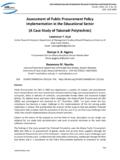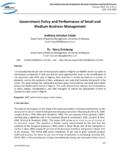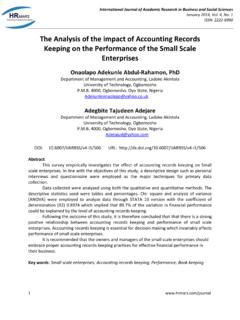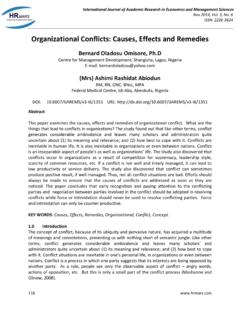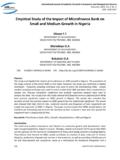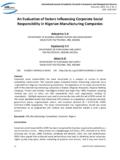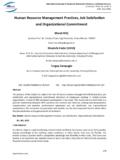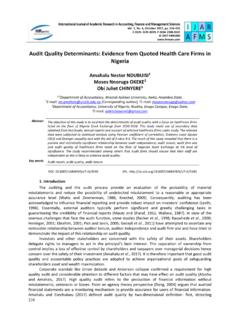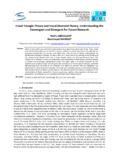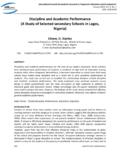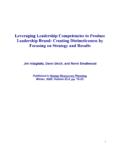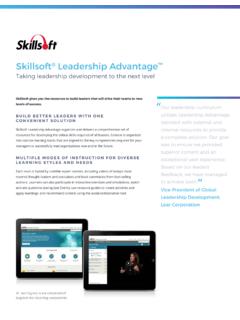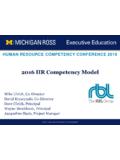Transcription of The Influence of Transformational Leadership on …
1 International Journal of Academic Research in Business and Social Sciences March 2016, Vol. 6, No. 3. ISSN: 2222-6990. The Influence of Transformational Leadership on Personal Branding through the Learning Organization and Consideration of Future Consequences Ali Osman UYMAZ. Graduate School of Business, Istanbul Sehir University, Kusbakisi Caddesi, No: 27. Altunizade, Uskudar, 34662, Istanbul, Turkey Email: DOI: URL: ABSTRACT. This study aims to analyze the direct and indirect effects of Transformational Leadership on personal branding through the learning organization and consideration of future consequences.
2 The research was undertaken at a corporation that provides its managers with Leadership and management training for organizational growth and has formed learning organization teams for this purpose. A group of 439 employees participated in the study. After applying a confirmatory factor analysis to the scales used in the research, the relationships among the research variables were analyzed, using the Structural Equation Modeling (SEM). According to the results of the study, the following were determined: a). Transformational Leadership has positive Influence on personal branding through the learning organization and consideration of future consequences, b) As the learning organization has direct positive Influence on personal branding, it also asserts indirect positive Influence through the consideration of future consequences, c) the consideration of future consequences has direct positive Influence on personal branding.
3 Key words: Transformational Leadership , learning organization, consideration future consequences, personal branding. Jel Codes: M12, M54, D83. 1- INTRODUCTION. In organizations that need to conduct their activities under constantly changing market conditions, jobs and duties have become more complex and cognitively demanding (Humphrey, Nahrgang, & Morgeson, 2007). This has resulted in the emergence of "knowledge workers" equipped with advanced knowledge, skills and education (Parker, Wall, & Cordery, 2001). Organizations in today's world expect employees to make a contribution to determining the corporation's vision and goals (Senge, Roberts, Ross, &.)
4 Kleiner, 1994), and even assign authority through delegation to employees at the lowest ranks of the company. These arrangements have created a proactive employee profile. They have also resulted in the formation of new attitudes and behavior that may be what organizations demand in few cases, but in others, they may only be defined as side effects (Vecchio, Justin, & Pearce, 2010). These new attitudes and behavior have made it necessary to redefine market changes, change management in organizations and the relations between the organization and its employees (Alvesson & Willmott, 2002; Alvesson, 2010.
5 1. International Journal of Academic Research in Business and Social Sciences March 2016, Vol. 6, No. 3. ISSN: 2222-6990. Smith, 2010). Du Gay defines relations that reference the market and the customer as "enterprise discourse" and the related dominating culture as the "enterprise culture" (1996). In order to respond rapidly to the rapidly changing conditions within the enterprise culture, the employee's new identity revolves around the "enterprising self" and "flexible subjectivity" (Sennett, 1998; Bauman, 2000). Here, the relationship between the organization and the employee has been transformed into the relationship between a customer and supplier, and this becomes the new meaning and model of membership in the organization (Vallas & Cummins, 2015), valid for all employees (Fenwick, 2002).
6 Amunsed and Martinsen describe this change as landscaping (2014). Managers are required to succeed in managing this process. In fact, the performance of a leader is evaluated on the basis of how this process is managed. The present language and rules and regulations of the market have turned into a single language, both for the organization and for the individual (Bolton & Houlihan, 2005). Contemporarily, there is great change in every field and Transformational leaders occupy a critical place in organizations. This is because Transformational leaders make an important and constructive contribution to employees, to the business and to the organization (Bass, 1999).
7 Transformational Leadership is a model of Leadership in which subordinates adopt a common organizational awareness and vision and are guided in the direction of achieving the targets and goals of the organization (Bass, Avolio, & Jung, 1995). The vision and support given to fulfill this vision that the Transformational leader provides subordinates with ensures that followers become high-performing individuals (Vera & Crossan, 2004), thereby promoting organizational development and simultaneous growth via personal improvement (Bass & Bass, 2008; Seltzer & Bass, 1990). This basic relationship between managers and subordinates must be managed and it is the potential that emerges from this effort that is converted into performance.
8 Goals defined for both the organization and the employee are what guide the attitudes and behavior of first the leaders, then of all employees (Thoms &. Greenberger, 1995; Zhang, Wang, & Pearce, 2014). This is why change and growth (Tsai, 2001) need to be managed from a multifaceted perspective (Berson, Nemanich, Waldman, Galvin, & Keller, 2006). Organizations use tools such as the learning organization, TQM, lean management, the Six Sigma to manage organizational change and growth. These tools are systematic growth models based on specific methodologies. Employees who work in line with these methodologies are trained, their knowledge and skills are enhanced, and they receive instruction particularly in project design, planning and implementation as they learn to manage using goals and targets.
9 In this context, Thoms and Greenberger have shown that people are closely interested in creating a vision based on a future time perspective and those who are given training as to how to develop a vision are future-oriented and become increasingly adept in defining a vision (1995). Similarly, methodologies and tools that teach projects such as the learning organization, TQM, lean management and the Six Sigma instigate intellectual and behavioral growth in individuals enabling them to apply what they have learned not only to the workplace but to their daily lives (Senge, 1990; Morales, Barrionuevo, & Gutierrez, 2012).
10 Organizations today take the market as their reference point for change. The organization's structure, its working norms and relations are redefined according to market conditions and employees are expected to be equipped with the knowledge, skills and competences, which will make them proactive players that will respond to the needs of the market. Du Gay asserts that the relationship between today's organization and the employee has 2. International Journal of Academic Research in Business and Social Sciences March 2016, Vol. 6, No. 3. ISSN: 2222-6990. transformed into the relationship between customer and supplier (du Gay, 1996).
